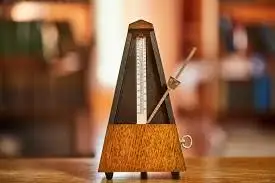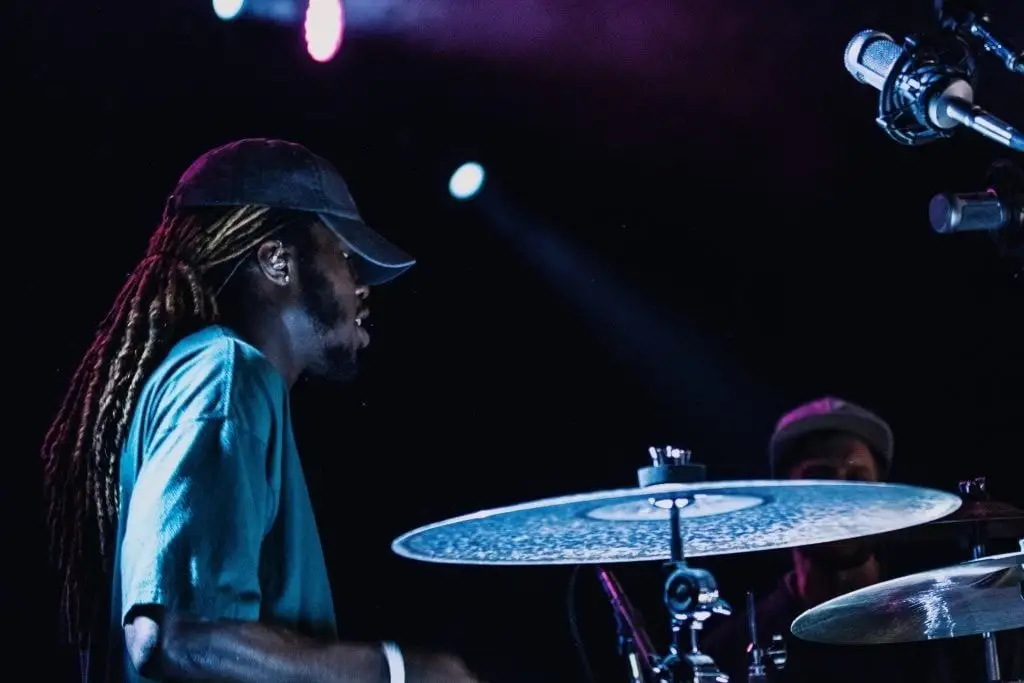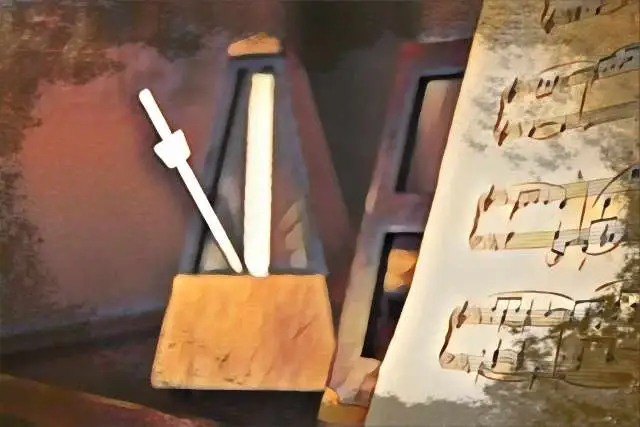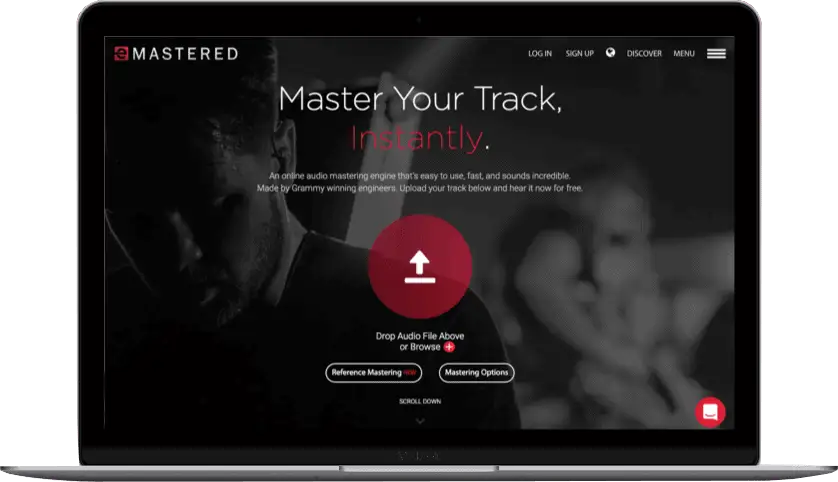I have a love/hate relationship with click tracks.
They’re crucial if you’re recording music in a studio with your band, but they can also suck the life out of your compositions. Similarly, artists can create immersive and richer live experiences by using them, but this can easily backfire if they rely too much on them.
As with many other tools, the secret is to use a click track wisely, but in order to do so, we need to understand what they are, how they can improve our musicianship, and how to make the most of them while keeping our music natural and genuine.
Definition of Click Track
A click track is a digital tool in your DAW that helps you keep a regular beat while recording, practicing, or performing live. It’s like a metronome, but with more features.
Whether live or in the studio, musicians listen to the click track through special headphones called in-ear monitors, so that its sound won’t be picked up by microphones capturing the actual instruments or voices.
What makes a click track so crucial in modern music is that it can be customized to a great extent: for instance, different sounds or cues can be added to help musicians understand what part of the song they are in, or to prepare them for changes like when to start or stop playing.
This is a great feature, especially when music needs to be synced with visuals or other audio sources. As a result, Walt Disney's team was the first to use the technology when recording sound effects and music for their early cartoons.
All in all, a click track is an upgraded metronome that can offer personalized cues, changes in the time signature, and clear guidance to musicians in the recording studio and on stage.
The Difference Between Click Track and Metronome

Both a metronome and a click track can help keep the same tempo while recording, practicing, or performing. But that’s where their similarities end.
I think we all know what a metronome is: a mechanical device or app used mainly during solo practice to help improve the sense of rhythm.
On the other hand, a click track is designed to work with other elements, like a backing track or videos, or to help musicians play together accurately. You can use it to match the music to visual effects during a live performance, or to trigger the backing vocals at the perfect time.
While a metronome usually just makes a simple ticking noise, a click track can be more complex and produce different audio cues for each performance, depending on one’s needs. This makes it the ideal tool to use to stay in sync with the backing tracks, visuals, and other musicians.
How Click Track Improves Musicianship

Over the last ten years, click tracks have changed the way musicians work together and think about timing when playing live.
A click track can signal when to switch sections in a song, like moving from a verse to a chorus or changing keys. In this way, all band members stay perfectly in sync and don’t have to worry about forgetting parts of a song.
Click tracks are absolutely crucial when syncing music with visual elements, be they background videos or dynamic light shows. They ensure that live instruments and pre-recorded elements blend seamlessly, taking the sound and energy to a whole new level.
Even while recording an album, a click track can become a fundamental part of a musician’s workflow.
Just like a metronome, a click track helps maintain a consistent tempo during studio recordings, but it also offers precious guidance to the recording musician, who will be prepared whenever there’s a change in the tempo or time signature in the track.
This is especially important for complex tracks with plenty of variations or even for session musicians who have little time to study songs but need to complete tasks in a short time.
This method also allows for easier editing. Sound engineers will be aware of all the variations in a song beforehand, so they can customize the mix to fit the song’s development without wasting precious time.
In short, a click track allows musicians to focus on playing the music with technical accuracy, offering guidelines that simplify and streamline the process of recording and performing live.
How to Program a Click Track
Most DAWs have built-in metronome or click track features that let you set the tempo and time signature easily; otherwise, you can use standalone apps designed just for making click tracks, like the FrozenApe’s Tempo app .
Now, set the click track to the BPM that matches your song. All DAWs these days allow you to manually enter the BPM or adjust it on the go, but if your song has tempo changes or different time signatures, you’ll need to figure out how to program these variations. In Studio One, the DAW I use the most, it’s fairly simple to do so, but in others it might not be as intuitive.
The standard click sound in most DAWs is a basic "tick" or "beep," but you can change it to anything you like. Some people prefer louder or different instruments, like woodblock clicks, because they naturally sound clear and loud.
I strongly recommend adding accents and subdivisions to make the beat clearer and easier to follow. Accents make certain beats stand out, while subdivisions break the beat into smaller parts, like eighth or sixteenth notes. The best click track is the one you can follow so effortlessly you don’t even think about it.
You can also add vocal cues to your click track. Simply create a separate audio track in your DAW, and record all the information you feel is necessary for the performance or use a text-to-speech converter. After that, mix the tracks together so you'll hear the click track and vocal cues clearly throughout.
Once you’ve programmed your click track, it’s time to test it out. Depending on why you need it, there are different paths you can take.
For recording sessions, keep it within your DAW project, so that musicians can hear it while recording their parts. For live performances, you’ll probably want to export the click track as a separate audio file and load it into a playback system, and direct it to in-ear monitors for each member, or just the drummer, who’s usually in charge of the song’s tempo and can guide the other instruments.
The Pros and Cons of Using a Click Track
I started this article by saying I have mixed feelings about click tracks. Over the years, they've proven to be extremely helpful at times, but I also saw situations when bands sacrificed a lot of their artistic expression for the sake of accuracy.
While there are plenty of positives about using a click track, it can turn the act of playing music into a mundane effort, with live shows following a strict structure that doesn't allow variations, and last-minute changes in songs in the recording studio becoming a nuisance.
In a nutshell, here are what I believe to be the pros and cons of using a click track:
Pros
- Music recording is made easier by clear guidance, personalized click tracks, and perfect timing.
- Perfect for live recording with visuals and backing tracks.
- Performances tend to go more smoothly.
- Great for last-minute session musicians, who can join in easily.
Cons
- Music is less spontaneous.
- Too much reliance on click tracks can result in a band not being able to play without it.
Final ThoughtsIn conclusion, I'd recommend that anyone exploring the potential of click tracks use them reasonably. Modern technology does sometimes fail, so having to cancel a gig or recording sessions because you can't perform without a click track is a sign that this tool affected your creativity and artistry.That said, when done right, click tracks can simplify every aspect of your music playing, and take your performance to the next level. So give it a go, and make sure you spend time personalizing your click tracks so that you can fully explore their potential.Have fun!





